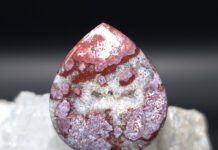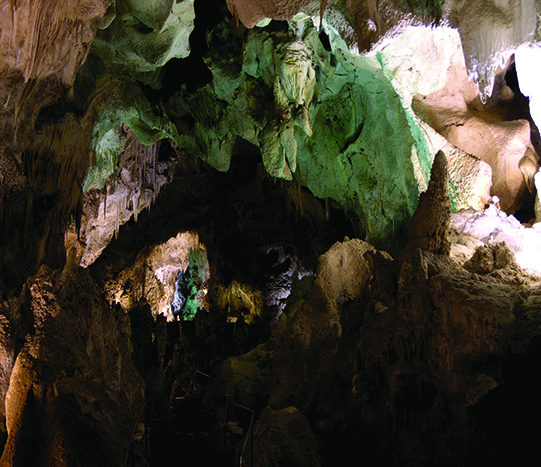
Carlsbad Caverns is located in a remote southern part of New Mexico, close to the Texas border. From the west, it is best reached via El Paso. Near Carlsbad, and a part of the same uplifted limestone formations is Guadalupe Mountains National Park. So any visit to one warrants a visit to the other.
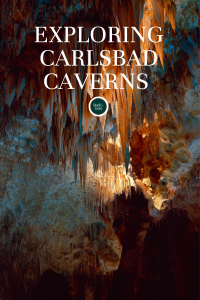
Mining Guano
When discussing caves of the National Parks in the United States, Mammoth Cave in Kentucky, Carlsbad Caverns in New Mexico, and Kartchner Caverns in Arizona share some similarities and exhibit major differences. For example, Mammoth Cave was mined for a mineral of destruction during the War of 1812, and Carlsbad was mined for minerals of growth and life.
Before the development of processes to manufacture fertilizers, the natural stuff was used. Behind every barn was the ever-present smelly pile of cow and horse manure to be spread on the land each spring during planting. World travelers found that other animal droppings, particularly that of flying creatures (not chickens), were another good option for the farmer. Bat guano was one such natural fertilizer. In regions where caves and their resident bats were known, mining bat guano developed into an important business for farmers. It provided a great off-season source of income to people who lived off the land.
Discovering Carlsbad Caverns
And so it was at the turn of the century when cowboy and guano miner Jim White decided to investigate a huge cavern from which hundreds of thousands of Mexican fruit bats issued each summer night. The bats fed on insects in the Pecos River Valley, migrating to Mexico each fall to return in late spring. (Remember this when you plan a visit to Carlsbad. The bats are in Mexico during winter).
One story about the discovery has it that Jim White was riding in the area around dusk one evening when he saw a huge black cloud rising from the hills. He thought it might be a fire, so he rode closer to investigate, only to discover a cave opening disgorging clouds of bats. More likely, he found out about the opening from some wandering local and determined to search it for guano.
Be that as it may, Jim discovered two important things in his investigation of the cave: stunningly beautiful cave formations and layers of guano, sometimes 30 or more feet deep on the cave floor. White did his best to convince people of the magnificence of what he found underground. But it took some time before the idea caught on. Soon Jim and a few others were taking people underground to see this breathtaking display of nature’s handiwork.
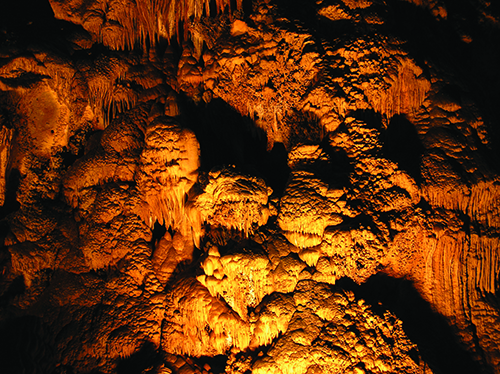
What to See in Carlsbad Caverns
Carlsbad’s spectacular formations today result from groundwater action dissolving and redepositing massive amounts of calcite limestone in the existing openings. It creates stalactites, stalagmites, travertine flows, and hosts of lesser but equally beautiful formations that far exceed what you will see in Mammoth Cave, where vastness is the prime attraction.
In Carlsbad, you can take several tours, most of which are relatively easy, some not. But none requires a hard hat, kneepads and such exertion as to leave you breathless.
Carlsbad Caverns Formation
Carlsbad formed somewhat differently from most scenic caves. The process that makes cave openings, including Carlsbad, is typical for limestone caves: the limestone’s dissolution by groundwaters. Yet, in Carlsbad, something special happened as these cave openings grew. There was a change in the dissolving ingredients — a dramatic change.
Generally, cave formations result from acidic waters containing carbon dioxide and organic matter, forming a weak carbonic acid. Water is, itself, a natural dissolver. But unless it is acidic, it works very slowly. Nature sees to it that the waters that seep underground are slightly acidic. As rain falls through the air, it absorbs minute quantities of carbon dioxide. When carbon dioxide reacts with water, it forms a very weak solution: carbonic acid. After it rains, this same, now slightly acidic groundwater absorbs organic matter from the soil as it works its way down to bedrock. This adds to its acidity.
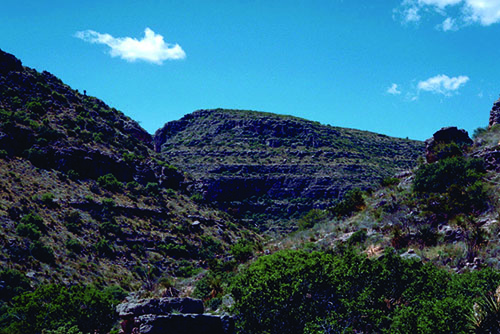
Travertine Falls
Bedrock in limestone country is anything but solid. Horizontal layers of limestone tend to develop cracks and joints — perfect avenues for this acidic water to reach deeper and deeper into the earth, dissolving away the limestone (impure calcite) as it goes. This creates the chambers, avenues, tunnels, and the like in the limestone. In many cases, the mineral-laden waters are drained away by underground streams. However, cave formations can also develop depending on conditions in the cave or even in a particular cave opening.
If they are not carried away by flowing water, any opening encountered allows the water to drop the mineral load, especially as the water evaporates. Thus, acidic groundwaters dissolve away the limestone, creating an opening that later groundwater may use as a dumping ground, depositing thin layers upon layers of calcite. If the water runs down the face of a cave opening, it creates solid “curtains” or “flows” that look like frozen waterfalls. These are sometimes called travertine falls. If water drips from a crack in the ceiling, it leaves behind a minuscule amount of calcite. This builds and builds to form stalactites. The water that drips to the floor also deposits calcite as it evaporates, building stalagmites. If the two should grow enough to connect, a column is created.
Gas & Oil Deposits Below Carlsbad Caverns
When Carlsbad was first studied, it was assumed that carbonic acid had been the key agent in the water that created this underground fairyland. Initially, this was true, as the groundwaters created the cavernous interior. But something happened on the way to modern times. Gas and oil deposits deep below the Carlsbad area began releasing gases, mainly hydrogen sulfide. As this poisonous and water-soluble gas rose toward the earth’s surface, it mixed with the down-trickling groundwater, forming a much more powerful dissolving acid. We call it battery acid! It is sulfuric acid, which is capable of dissolving the proverbial kitchen sink.
What happened here is virtually the same as what happens when sulfur-bearing ores decompose and release sulfur, often in the form of hydrogen sulfide. This chemical attacks the primary ores, creating a whole new, and more easily smelted, zone of secondary or oxidized ores. These oxidized ores near the surface of a metal vein are largely responsible for many of the beautiful minerals we collect. The ores are important to the early development of mining in this country, as oxidized ores could be smelted while sulfides could not ….until the development of chemical means of breaking down the sulfides.
Cave Formations in Carlsbad Caverns
Because Carlsbad’s waters were much more acidic than other caves, thanks to sulfuric acid, the limestone was attacked very vigorously. The resulting calcium carbonate-laden waters at Carlsbad provided the raw materials that created Carlsbad’s abundance of huge caverns that can be found in overwhelmingly beautiful cave formations.
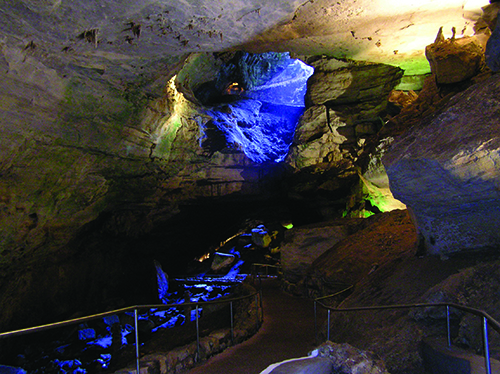
A visit to the Big Room is evidence of that. The room covers 14 acres and is over 750 feet beneath the earth’s surface. It took several million years to create the cavern openings here, and another half-million to create the wonders you see on an easy hike underground.
An elevator brings you back to the surface so that even older folks and small children can revel in the wonders of Carlsbad. There is even a restaurant and gift shop below ground so you can leave some of your money in the cave, too.
Guadalupe Mountains
Carlsbad is actually in the same limestone formations as the Guadalupe Mountains, which are composed of some of the extensive and significant members of the Permian limestones in the U.S. Permian rocks are the source of much oil and natural gas in Texas and elsewhere. Permian-age material formed just before the Age of Dinosaurs, some 200 million years ago.
The Guadalupe Mountains’ most impressive feature is the Capital Reef, a high escarpment or cliff area where the land has been uplifted dramatically. The rocks that comprise the reef are fossil limestone, and one portion of it, El Capitan Cliff, rises over 1,000 feet above the surrounding parched land. A visit here is fascinating because of the early sea life fossils and the so dramatically different vegetation from the arid terrain surrounding it.
This story about Carlsbad Caverns previously appeared in Rock & Gem magazine. Click here to subscribe! Story by Bob Jones.




